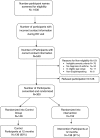The influence of community violence and protective factors on asthma morbidity and healthcare utilization in high-risk children
- PMID: 24889008
- PMCID: PMC4134443
- DOI: 10.1007/s11524-014-9883-6
The influence of community violence and protective factors on asthma morbidity and healthcare utilization in high-risk children
Abstract
We examined the longitudinal effects of community risk and protective factors on asthma morbidity and healthcare utilization. Three hundred urban caregivers of children with poorly controlled asthma were enrolled in a randomized controlled trial testing the effectiveness of a behavioral/educational intervention and completed measures of exposure to community violence (ECV), social cohesion (SC), informal social control (ISC), child asthma control, child asthma symptom days/nights, and healthcare utilization. Latent growth curve modeling examined the direct and interaction effects of ECV, SC, and ISC on the asthma outcomes over 12 months. Caregivers were primarily the biological mother (92 %), single (70 %), and poor (50 % earned less than $10,000). Children were African American (96 %) and young (mean age = 5.5 years, SD = 2.2). ECV at baseline was high, with 24.7 % of caregivers reporting more than two exposures to violence in the previous 6 months (M = 1.45, SD = 1.61). Caregiver ECV-predicted asthma-related healthcare utilization at baseline (b = 0.19, SE = 0.07, p = 0.003) and 2 months (b = 0.12, s.e. = 0.05, p = 0.04). ISC and SC moderated the effect of ECV on healthcare utilization. Our findings suggest that multifaceted interventions that include strategies to curb violence and foster feelings of cohesion among low-income urban residents may be needed to reduce asthma-related emergency services.
Figures
References
-
- Sterling Y, Peterson J. Characteristics of African American women caregivers of children with asthma. Res Nurs Health. 2003;28:32–38. - PubMed
-
- Wright K. Disparities and predictors of emergency department use among California’s African American, Latino, and White Children aged 1–11 years with asthma. Ethn Dis. 2009;19:71–77. - PubMed
Publication types
MeSH terms
Grants and funding
LinkOut - more resources
Full Text Sources
Other Literature Sources
Medical


